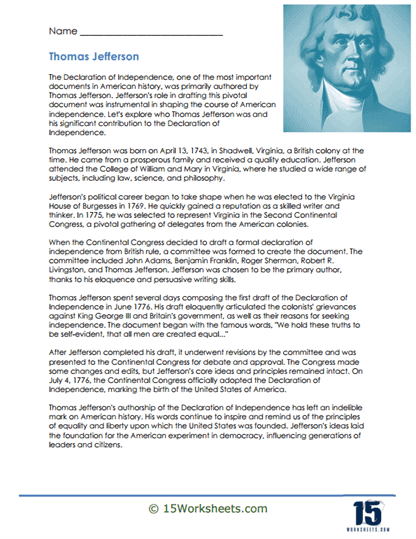

These Declaration of Independence worksheets were created to enhance student understanding of one of the most significant documents in American history. These worksheets encompass a variety of exercises, each meticulously crafted to deepen students’ comprehension of the Declaration of Independence and its profound impact on the notion of individual rights in the United States.
By engaging with these exercises, students enhance their comprehension of the historical context, philosophical underpinnings, and lasting impact of the Declaration. This, in turn, fosters a more profound appreciation and understanding of their rights as American citizens, empowering them to be informed and active participants in the democratic process.
Reading Comprehension Questions – Following a close reading of the text, students answer questions that test their understanding. These questions may range from factual-focusing on the who, what, when, and where-to analytical, requiring students to infer motives and outcomes from the document. These exercises push students beyond mere factual recall. Here, students analyze the reasoning behind the Declaration, assess its arguments, and evaluate its effectiveness and impact. They may compare the Declaration to other historical documents or discuss its relevance today.
Vocabulary Exercises – These segments introduce students to pivotal terms found within the Declaration of Independence. Students match words to their definitions, fostering a comprehensive vocabulary that is crucial for understanding the document’s content and context. This activity requires students to complete sentences with appropriate words from the Declaration. It ensures that students pay close attention to the document’s language and phrasing, which is crucial for comprehending its message and intent.
Essay Prompts – These prompts encourage deeper reflection on the Declaration’s principles and its role in shaping individual rights and government policies. Essays might address the philosophical underpinnings of the Declaration, its influence on American political thought, or its relevance in contemporary society. These activities foster collaborative learning and critical thinking. Students engage in discussions or debates on topics related to the Declaration, such as its implications for modern-day America or its role in global human rights discourse.
The worksheets build a foundational understanding of the Declaration of Independence. Knowing what the document says, whom it was addressing, and why it was written is crucial for understanding the historical context of American rights.
The exercises encourage students to think critically about the content and significance of the Declaration. By analyzing the arguments made and assessing their validity and impact, students develop a nuanced understanding of how the ideas expressed in the Declaration shape the concept of individual rights.
The Declaration of Independence is a foundational document in American history, adopted by the Second Continental Congress on July 4, 1776. Crafted by Thomas Jefferson and revised by the committee and Congress, it marks a seminal moment in the birth of the United States of America. The Declaration is much more than a mere announcement of separation from Great Britain; it is a profound statement of national and philosophical identity, articulating a vision of sovereignty, individual rights, and the role of government.
The Declaration was conceived in a time of escalating tension between the thirteen American colonies and Great Britain. Grievances against British policies, taxation without representation, and the absence of self-governance reached a boiling point, prompting the colonies to seek independence. The Declaration served multiple purposes – it was a formal announcement of independence, a statement of principles, and a call to arms for the colonists. It also aimed to garner international support, particularly from France, by articulating the colonies’ cause in a manner that appealed to Enlightenment principles prevalent in Europe.
The Declaration of Independence is structured into a simple yet powerful framework, consisting of a preamble, a statement of principles, a list of grievances, and a declaration of independence.
Preamble – The preamble sets the stage. It introduces the document’s purpose and the necessity of explaining the reasons compelling the colonies to separate from Britain.
Statement of Principles – This section articulates Enlightenment ideals and the philosophy underpinning the new nation. The most famous lines assert that all men are created equal, endowed with unalienable rights, including life, liberty, and the pursuit of happiness. It establishes the principle that governments derive their power from the consent of the governed and that the people have the right to alter or abolish a government that becomes destructive to these ends.
List of Grievances – The longest section enumerates the colonies’ grievances against King George III and British governance. These grievances illustrate the colonies’ view that their rights as Englishmen and principles of governance through consent had been systematically violated. Grievances include imposing taxes without consent, dissolving representative legislative bodies, maintaining standing armies in peacetime without consent, cutting off trade, and denying trial by jury.
Declaration of Independence – The conclusion is a resolute statement of sovereignty. It declares the colonies to be free and independent states, absolved from all allegiance to the British Crown. The signatories, representing the United States, assert the right to levy war, conclude peace, contract alliances, establish commerce, and do all other acts that independent states may rightfully do.
Impact and Legacy
The Declaration of Independence had an immediate and lasting impact. It unified the colonies in their fight against British rule, providing a clear statement of purpose and principles. Internationally, it positioned the American cause within the broader Enlightenment context, resonating with global philosophies about governance, rights, and the nature of sovereignty.
The legacy of the Declaration is profound and enduring. Its articulation of individual rights and government’s role in securing these rights has been a beacon for democratic movements worldwide. The principles enshrined in the Declaration continue to shape American identity, political philosophy, and civic discourse.
In essence, the Declaration of Independence is not just a historical document but a living testament to the American ideals of liberty, equality, and democratic governance. It stands as a powerful testament to the human aspiration for freedom and the right to self-determination, continuing to inspire and challenge generations to live up to its lofty ideals.